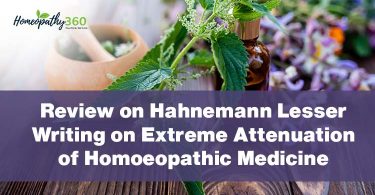
ABSTRACT
Ever since the homoeopathy was discovered by Dr Hahnemann, its modus operandi or working principle always has remained unexplained. No visible or detectable medicinal ingredient in the remedies was the main reason behind this. Due to this reason, it has always been attacked by its opponents as placebo effect or lack of scientific legitimacy.
ABBREVIATIONS
Ars. –Arsenicum album, CCL4- carbon tetrachloride, DNA- deoxyribonucleic acid, Vol.- volume, WBC- white blood cells.
INTRODUCTION
Since the time of discovery of homoeopathy (1796), homoeopathy is being attacked by its ignorant opponents, so-called “skeptics” about its “modus operandi”, mostly because of the easiest misleading demonstration that there is no visible or detectable medicinal ingredient in the remedies as they are diluted beyond their understanding. The most common subject of skepticism towards homoeopathy has been the exceedingly small doses of medicine being used in the treatment and cure of patients. Skeptics of homoeopathy have asserted that there are no molecules left in the highly diluted homoeopathic solutions.
EVOLUTION OF MINIMUM DOSE
Homoeopathy was crystallised into a medical system in the late 18th century by Samuel Hahnemann but soon Hahnemann became disillusioned with his inability to cure his patients. After withdrawing from medical practise and engaging instead in translating medical Hahnemann came across William Cullen’s Materia Medica and its pathogenetic description of cinchona bark.
Hahnemann ingested some of the bark and recorded the symptoms he subsequently experienced. Hahnemann thus elaborated the six principles of homoeopathy. First, the law of similia, i.e. “like cures like”. Second principle, the principle of the minimum dose denoting that in all cases, the smallest drug dose possible should be used in order to achieve a therapeutic effect without harmful consequence.
Through experimentation, Hahnemann came to dilute drugs to such a degree that no material substance of the original drug was left in the diluent. This process, which Hahnemann called “dynamisation”, enhanced the drug’s therapeutic power whilst minimising its side effects, and was explained by him in terms of the release of energy (dynamis) from matter in the process of succussing (shaking) the remedy between dilutions. This eventually led to the million, millionth dilutions and beyond, what came to be known as the “infinitesimal dose.”
Before his discovery, Hahnemann claimed people witnessed this law or “spiritualisation” in the form of friction (the generation of heat via rubbing) and the magnetisation of a steel rod by rubbing it strongly in one direction with a blunt knife. Hahnemann also stated that trituration and succussion release the “spirit like medicinal power” of the medicine1.
Hahnemann and his successors have generally agreed that potentisation increases the power of medicine, making the 30th dilution stronger than the 20th and the 20th stronger than the 10th 2.
The first hint of an explanation of the mode of action of remedies occurs in the Medicine of Experience (1805) as, “when two abnormal general irritations act simultaneously on the body, if the two be dissimilar, then the action of the weaker will be suppressed for some time by the stronger.”As an illustration of this, Hahnemann cites the suppression of measles by small-pox, and of the plague by the same disease3.
Another one is, “when the two irritations greatly resemble each other, then the weaker, with its effects, will be completely extinguished and annihilated by the analogous power of the stronger.”
In the preface to the fourth vol. of the The Chronic Diseases, 1838, Hahnemann attempted another explanation of the curative of the curative process, which is,
“It is undeniable that our vital force is unable, without the assistance of true curative agents, administered by human skill, to combat with inconsiderable acute diseases (if even it do not succumb to them), and to re-establish a sort of health, without sacrificing a portion (often a large portion) of the fluid and solid parts of the organism in what is called a crisis. How it affects this will remain forever unknown to us; thus much, however, is certain, that it cannot overcome even these diseases in a direct manner, not without such sacrifices.
OPPOSITION TO HOMOEOPATHY
Hahnemann published his first essay in Hufeland’s journal and so the very first criticism of homoeopathy appeared in the journal der erfindungen by Hecker. He said, “Hahnemann’s principle is a principle without a principle.”
Another detailed criticism appeared in 1811 in Med. chir. Zeitung where Hahnemann was blamed as irrational and illogical in his thinking4.
A severe blow to homoeopathic law of minimum dose came from the chemical school, particularly by avogadro’s law, published as a hypothesis in 1811 and tested experimentally by Millikan in 1909. This law established that one mole of a substance contains 6.022140857 × 1023 molecular units. As a result, by simple calculation, it can be explained that dilution of a substance beyond 1023, which is homoeopathic 12C potency, does not contain any molecule or atom of that substance5.
EVIDENCES IN FAVOUR OF MODUS OPERANDI OF HOMOEOPATHY
- EMPIRICAL EVIDENCES
The initial type of evidences regarding the efficacy of Homoeopathy is solely based on the experiences of Hahnemann and different stalwarts. During the late 18th and 19th century, the proponents of unconventional medicine relied principally on the assumptive world of animal magnetism, an ethnic medium ritualised by Franz Anton Mesmer. For those more inclined to spiritual aspect of medicine, the worldview of theologian Emanuel Swedenborg served as the metaphor for the primacy of spirit over matter6.
In the 19th century, homoeopathy was not an “alternative medicine” but part of “science”. In the latter half of the 19th century, homoeopaths were attempting to put the homoeopathic law of similia similibus curentur onto an even more scientific footing. For them, this law was to medicine what Newton’s laws of motion and gravity were to physics. By the last quarter of the 19th century, homoeopaths were looking for “scientific” explanations of how similia and minimum dose worked. At the end of 19th century, came the Arndt-Schulz rule regarding the effects of medicine in different concentrations.
By the early 20th century, homoeopaths were forming an alliance between homoeopathy and Mendelian genetics5.
- LABORATORY EVIDENCES
The most serious obstacle to clinical research in homoeopathy is of methodological nature, in the drug prescribing is based fundamentally on individual symptomatology, and not so much on diagnosis of actual disease. Although many clinical trials published till date are of low quality, there is small but a significant body of work reporting positive evidence in favour of efficacy of homoeopathic modus operandi.
Ferley and coworkers also used homoeopathic complexes in treatment of influenza. They conducted two studies, the first based on methods of low dilution combination pharmacology in which the incidence and duration of symptoms were no different in group treated with complex compare to group treated with placebo. However, the 2nd study used a unique homoeopathic preparation called OSCILLOCOCCINUM, consisting essentially of a high korsakovian dilution (200 k) of Anas barbariae (duck) liver and heart extract.It shows significantly increase number of cures within 48 hours of diagnosis6.
In the 1990s, a study was performed on the effects of highly diluted thyroxine on frog metamorphosis. This model represented one of the most discussed examples of the biological effects of high dilutions over the next two decades. In 2010, another critical conceptual review of the use of animal models in homoeopathy and high-dilution research was published6.
In toxicology, an attempt has been made to investigate whether high dilution of a toxic substance is capable of modifying either its elimination or its consequences.A number of studies has demonstrated that the 700th dilution of Ars and Bismuth is capable of increasing the urinary excretion of same metals in rats. The effect of high dilution of CCL4 confirmed similar data in non-homoeopathic literature. It has also been reported that small doses of cadmium reduce the renal toxicity caused by the same metal in the rat6.
The most significant in vitro study was conducted on human basophils using the degranulation test by Jacques Beneveniste (1981). Beneveniste conducted a series of experiments that measured the response of human WBC’s to an antibody that has been diluted in distilled water to a point where the solute contained no remaining molecule of active substance. Beneveniste and his colleagues theorised that the antibodies have left their “imprint” on the water molecule and this “imprint” was sufficient to cause a reaction from WBC7.
An extraordinary paper authored by Nobel prize-winning Luc Montagnier has shown memory effects in aqueous DNA solutions that depend on interactions with the background electromagnetic field. These effects require the prior processing and dilution of the solutions and are explained as resonance phenomena with nanostructures derived from the DNA and water. As applied to homoeopathy, the ‘memory of water’ concept should also be extended to the memory of aqueous ethanol preparations, which are also used8.
Further a three-step working hypothesis was given by George Vithoulkas to explain the specific organisation of molecules of the solvent in homoeopathic microdilutions which can maintain the properties of an initial substance not effectively present9.
CONCLUSION
It matters little what may be scientific explanation of how it takes place; and I do not attach much importance to the attempts made to explain it (aphorism 28).1
It is true that homoeopaths are not entirely certain of working principle of homoeopathic medicines, but to be entirely honest, there are various modern medicines and many antibiotics whose mode of action is not completely known.
Although many papers on experimental research in homoeopathy have so far been published from well-established laboratories demonstrating positive effects on the mechanism of action, particularly of the higher potencies that can bring forth spectacular changes in living organisms but none has been properly dealt with by most authors.
One great difficulty that stands for criticism is the lack of understanding of what actually happens after the highly diluted ultra-low dose of the drug is administered on tongue. Tracing the movement of the ‘molecular imprint’ through receptors or nerve cells in the absence of the original ‘drug molecule’ or pinpointing the mechanism(s) and pathway(s) of action of the drug after it is administered on the tongue of a patient or an experimental animal is simply impracticable.
Modus operandi of homoeopathy can be explained in following ways:
- THROUGH PHENOMENOLOGICAL EXPLANATION, i.e. facts speak for itself
- THROUGH IDEOLOGICAL IMPLICATION, i.e. various theories and schools of thoughts.
- THROUGH LABORATORY AND RESEARCH BASED EVIDENCES, i.e. various studies published time to time.
- And the last one is through ARGUMENTS.
“It has been my rule through life never to accept anything as true, unless it came as near mathematical proof as possible in its domain of science; and on the other hand, never to reject anything as false, unless there was stronger proof of its falsity.”
- Constantine Hering (1800-1880)
REFERENCES
- Hahnemann, S., Organon of Medicine, 6th edition, English translation, Boericke W, Boston, 1921. Indian edition, B. Jain, New Delhi.
- Coulter L. Harris, Divided legacy, Volume III, North Atlantic publications, USA, p 57-58.
- Dudgeon R.E., The lesser writings of Samuel Hahnemann, p 447-448.
- Ameke W., History of Homoeopathy, its origin and conflicts, translation by Drysdale, British homoeopathic society, p 172.
- Jones B., How medicine could have developed differently: A Tory historiographical analysis of the conflict between allopathic and homoeopathic medicine in America and Britain from 1870 to 1920.
- The use of animal models in homoeopathic research – a review of 2010– 2014 PubMed indexed papers, Homoeopathy, Volume 104, Issue 4, October 2015, Pages 283-291.
- Benveniste, J., et.al. (1988): Human basophil degranulation triggered by very dilute antiserum against IgE, Nature, 30 June, 333(6176):816-818.
- Bellavite P, Emerging science of Homoeopathy: Complexity, biodynamics and nanopharmacology, P 11-12.
- Montagnier L., et.al., Electromagnetic signals are produced by aqueous nanostructures derived from bacterial DNA sequences, Interdiscip. Sci. Comput. Life Sci. 1 (2009) 81-90.
- Anagnostatos G.S., Vithoulkas G. et.al., A Working Hypothesis for Homoeopathic Microdiluted Remedies.
About the authors:
Dr Payal Gupta
Dr Abhilasha Pramanik
Dr Aastha
All pursuing MD Organon of Medicine and Homoeopathic Philosophy (Bakson Homoeopathic Medical College)




